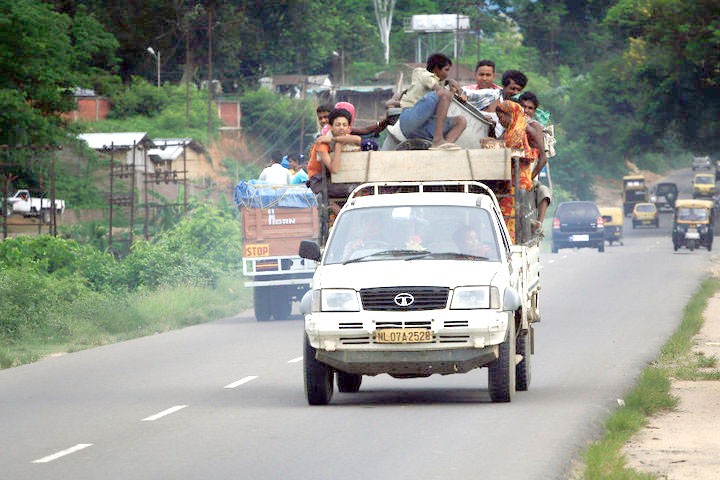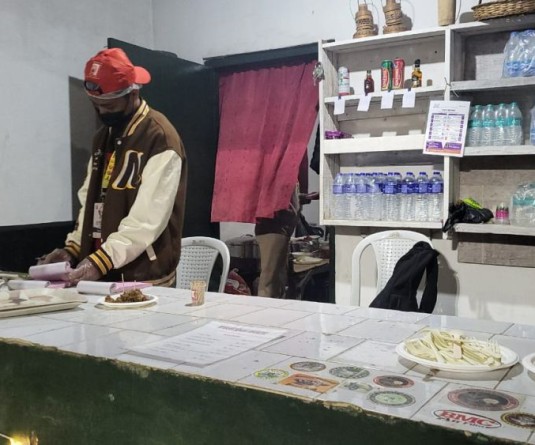Vehicles ply along the National Highway in Dimapur. Without commercial roads for trucks and other heavy vehicles, added to the poor road conditions throughout the state, Nagaland’s economy suffers heavy loses. (Sorei Mahong photo)

Morung Express News
Dimapur| September 23
Economists have often said that good roads and economic growth go hand in hand. In Nagaland, the pathetic road condition reflects the poor economic status of the State. And these bad roads aren’t just an inconvenience or a black mark on the quality of life indicator chart. They’re costing the State—its drivers and its businesses—big time, and hampering economic development efforts in the process.
According to reports, incessant rainfall this year has damaged nearly 30% of the State roads and almost 10% of the National Highways in Nagaland. The State is losing heavily due to unnecessary increase in vehicle operating costs and loss of road asset value alone.
Operating costs of heavy commercial vehicles have increased by two third. Earlier the hire cost of truck carrying nearly 15 ton load from Dimapur to Kohima was Rs.6, 000 to Rs.6, 500. The cost has increased to Rs.9, 000 for 12 tons load. From Dimapur to Zunheboto, the cost has increased from Rs.17, 000 to Rs.20, 000. Similarly, the costs from Dimapur to Imphal and Ukhrul have increased to Rs.30, 000 to Rs. 34, 000 respectively. Owing to bad road conditions, the government has ordered all trucks not to carry more than 10 ton load. However, truckers are still charged with toll tax, and to make up for the same, continue to carry more than 10 tons. The condition prevails throughout the entire state.
Economists believe that in Nagaland motorists pay dearly in additional vehicle operating costs as a result of poor road condition. Congested roads cost the State in the form of lost time and wasted fuel, which is something businesses with large fleets really feel. It takes almost double the time now to reach their destination due to bad road condition; especially those carrying perishable goods feel the loss. Bad roads have made it very difficult to attract businesses into the State “Expansion of business results in growth of economy,” Toshizenba, a Lecturer in Economics said. He said better roads means lesser time for goods to reach, which will fetch better prices (in the case of perishable goods). The case is not so in Nagaland, thus, weighing heavily on businesses.
The absence of commercial roads in Nagaland has also been a big drawback for the growth of the State economy. Although some Economists differ in opinion saying having commercial roads is not necessarily a criteria for economic growth, it has certainly been a stumbling block for the State’s economy. “We have to wait till its 2 pm to get the green signal for departure…which means we are losing travel time,” a trucker said. Trucks, light and medium vehicles, motorcyclists, pedestrians and even bullock carts use the same road in Nagaland. While highway projects that fall into the economic development category, it is anybody’s guess where the money is going. In other bigger cities, trucks travel on commercial roads where toll taxes are taken to maintain the roads. But in Nagaland, toll tax is simply taxing.
While successive governments and contractors have failed to provide better roads, Economists argue that the public are also to blame. “Bad roads means people are not walking the roads often…which again means people are not working enough,” an Economics professor said. He believes that the Naga economy is in ruins as most wealth generated is being drained out of the State. There is a very small section of people in Naga society who understand economics. But instead of aiding and designing economic growth and human development, they are confined to the elite class, he argues further. So while Naga politicians and bureaucrats keeping harping on sustainable economic growth, unless they understand the conditions needed to attain it, matters will lie still.






